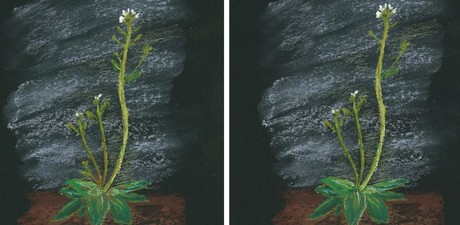Variable gene expression helps plants survive environmental change

As parents of identical twins will tell you, their children are not actually identical, even though they have the same genes. This is also true in the plant world.
Now, researchers from the University of Cambridge have discovered how ‘twin’ plants with identical genes, grown in identical environments, continue to display unique characteristics all of their own. Their work has been published in the journal Molecular Systems Biology.
Plant scientists at the Sainsbury Laboratory Cambridge University (SLCU) have built a gene expression atlas that maps the ‘noisy genes’ of genetically identical plants and found that around 9% of the genes in otherwise identical plants are highly variable in the way that they behave. Interestingly, many of these highly variable (noisiest) genes help a plant respond to its environment, including genes involved in reacting to light, temperature, pathogens and nutrients. This is the first time that global levels of noise in gene expression have been measured in plants.
What is gene expression?
Looking at the full genetic code (genome) of an individual plant or animal is not enough to fully understand the individual’s characteristics, as the way genes behave (gene expression) can differ markedly between individuals with the same genome. A gene is expressed when the genetic code of the gene is used to direct a set of reactions that synthesise a protein or other functional molecule within a cell. Copying a segment of DNA to RNA is the first step in this sequence and is called transcription. In this study, ‘noise’ in gene expression refers to the measured level of variation in RNA between individual plants. Measuring the variability in gene expression reveals which genes are noisier than others.
The SLCU’s Dr Sandra Cortijo is researching how gene expression is regulated and what causes some genes to be expressed in unpredictable ways. To examine this, she took on the mammoth task of measuring global levels of noise in gene expression in a single plant species. Using genetically identical plants, she measured the expression of all their individual genes over a 24-hour period.
“For our model plant, we used seedlings of a small wild brassica relative, called thale cress (Arabidopsis thaliana), which is most commonly seen growing as a weed in the cracks of pavements,” Dr Cortijo said. “We performed RNA-sequencing on individual seedlings every two hours over a 24-hour period and analysed the variability for 15,646 individual genes in the plant’s genome.
“We identified that 9% (1358 individual genes) of the genes were highly variable for at least one time point during the 24-hour period. We found that these highly variable genes fell into two sets influenced by the diurnal cycle — genes with more variable activity at night or genes that have more variable activity during the day.”
As part of the study, Dr Cortijo also identified factors that might increase gene expression variability. Highly variable genes tend to be shorter, to be targeted by a higher number of other genes (transcription factors) and to be characterised by a ‘closed’ chromatin environment (which is an environment that allows gene expression to be altered by attaching additional molecules during the gene reading process (transcription) without actually changing a cell’s DNA).
“These results shed new light on the impact of transcriptional variability in gene expression regulation in plants and can be used as a foundation for further studies into how noisy genes are connected with how plants respond to their environment,” Dr Cortijo said.
This variation in gene behaviour could be useful in nature for populations of genetically similar plants to hedge against environmental stress such as drought, high salinity or extreme temperatures. This means that there will always be a few plants in the population that are prepared to survive different stresses due to their variable gene behaviours. But this variability can also be a problem, such as in agriculture where environments are more controlled and farmers want uniform crops that germinate and flower at the same time and respond equally to applications of fertilisers and water.
“The evolution of variable gene expression could increase the robustness of a plant population against varying environments without changing their genes,” Dr Cortijo said. “Understanding how plants produce and regulate this noise in gene expression will be important for the future development of more uniform performing crops and to understand how populations of wild plants can survive more frequent weather extremes due to climate change.”
Dr Cortijo’s data can be found in the online open-access atlas AraNoisy — a web-based tool enabling plant scientists around the world to study how gene expression variability influences plant survival and diversity within clonal populations. According to SLCU Research Group Leader Dr James Locke, the data serves as a significant new resource for further research.
“This is an important resource for scientists studying how genetically identical plants survive fluctuating environments and provides a basis for future work looking at how genetic and epigenetic factors regulate variability for individual genes,” Dr Locke said.
The atlas can be viewed at https://jlgroup.shinyapps.io/AraNoisy/.
Follow us on Twitter and Facebook for the latest industry news. To receive our bimonthly magazine and weekly newsletters, click here.
European Space Agency inaugurates deep space antenna in WA
The ESA has expanded its capability to communicate with scientific, exploration and space safety...
Black hole collision supports Hawking's landmark theory
Astrophysicists have witnessed a collision between two black holes that was so loud, they were...
Uncovering differences in wild and domesticated crops
Researchers have revealed insights into the genetic make-up of wild varieties of common crops...





